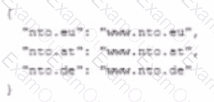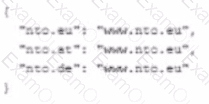An Architect has been approached by the Business with a request to create a custom product finder. The finder would initially be available ononly one site, and would eventually be extended to be available on all sites the Business maintains. There is a requirement that these wrings art also available to be used in a Job context for export to other systems.
Each site will have a differentcategory avertable for use by the product finder.
Where should the Architect store the custom settings for use on both the storefront and in a job context?
An Architect is configuring a data replication schedule.
Which task(s) can be removed In order to reduce replication times?
A client has a single site with multiple domains, locales, and languages. Afterlaunch, there is a need for the client to perform offline maintenance. The client would like to show the same maintenance page for each locale.
Which version of aliases,Json file below will accomplish this task?
A)

B)

C)

D)

The Client identifies that a segment of customers need to see some products on the site that other customers should not be able to access. All products are maintained within one catalog but in separate categories. A custom attribute will be used on the Profile system object to identify customers that belong to this special segment. A customer group will be made that is qualified for by this Profile custom attribute. The storefront will be customized to include navigation to relevant categories for this customer group.
Unfortunately during technical review the Client points out that the business teams have raised a concern with maintenance and want to use a shared navigation within the catalog and not use separate categories.
Which item should the Architect suggest to efficiently fulfil this new requirement while maintaining scalability?
The Client is creating a new Storefront and their requirements include:
• ApplePay support
• Log -n through a standard OAuth2 social media account
• One Okie checkout process
• Ay B testing forpromotions
Which two items require technical documentation for customizing the Storefront Reference Architecture?
Choose 2 answers
During a technical review, the Client raises a need to display product pricing on theProduct Detail Page (PDP) with discounted values per promotion. The Client notes customers complained of bad user experiences in the past when they would add a product to the basket from the cached PDP and then see a higher price when they started checkoutas the promotion had expired.
What should the Architect suggest be implemented for this given that performance should be minimally impact?
An Architect is documenting the technical design for a single B2C Commerce storefront. The Client has a business requirement to provide pricing that is customized to specific groups:
• 50 different pricing groups of customers
• 30 different pricing groups of employees
• 10 different pricing groups of vendors
Which items should the Architect include in the design in order to set applicable price books based on these requirements''
Choose 2 answers
The Client is planning to switch to a new Payment Service Provider (PSP). They have approached an Architect to understand the time and effort to Integrate the new PSP The PSP offers a LINK cartridge compatible with SiteGenesisPipelines, but the Client’s website is build on Controllers.
Which two options should the Architect take into consideration before starting analysis? Choose 2 answers
A Retailer has a single storefront site and a Product Management System (PIM). The Pin is Generating the master catalog and storefront categorization catalog every day and it uploading them toSFTP
how should the Architect configure the import job flows following the best practices?
An Order Management System (OMS) handles orders from multiple brandspecific sites, as part of the processing, the OMS sends the processing detail to be added at notes to the orders in B2C Commerce. These processing details are captured temporarily in custom objects, and are later processed by a batch Job that:
• Processes the custom object to extract the orderid and note data.
• Tries to load the order.
• If the order is not found, it deletes the custom object and moves on.
• If the order is found, it updates notes In the Order, upon successful update of this order, it deletes the custom object.
There is an Issue reported that the job is constantly failing and custom objects are growing in number. On investigating the production look the message below is being logged on each failure:

What are three solution The Architect can take to fix this issue without losing meaningful data?
Choose 3 answers

